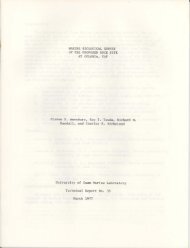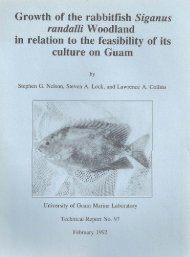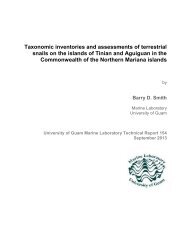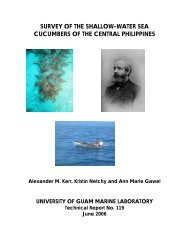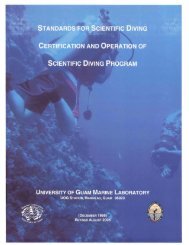Marine Protected Area Surveys Central Visayas, Philippines 2007
Marine Protected Area Surveys Central Visayas, Philippines 2007
Marine Protected Area Surveys Central Visayas, Philippines 2007
Create successful ePaper yourself
Turn your PDF publications into a flip-book with our unique Google optimized e-Paper software.
Raymundo and Maypa 2008 UOG Tech. Rep. 122<br />
Disease prevalence was low inside the Balicasag MPA (2.2%), but much higher in the<br />
fishing ground (7.1%). These values increased from 2006; total prevalence was 0.25% within<br />
the MPA and 0.29% in the fishing ground in previous surveys. White Syndrome was the<br />
dominant disease, patchy bleaching was also common, and predation by Drupella and Crownof-Thorns<br />
starfish were also observed.<br />
Tawala, Panglao<br />
This reef was not<br />
previously surveyed in 2006, so<br />
the data here represent a baseline.<br />
The Tawala reef was marked by<br />
high relief and complexity and very<br />
high coral cover (Fig. 4 and 5),<br />
dominated by the genus Porites<br />
(Fig. 9). The reef crest was in very<br />
good condition, and there was little<br />
dead standing coral and coral<br />
rubble, both within the MPA and in<br />
the fishing ground. The reef flat Figure 9. The Tawala MPA reef crest, showing dominance<br />
by Porites cylindrica with high relief and high cover.<br />
was dominated by the macroalga<br />
Sargassum and soft corals. As with Balicasag, there was little difference in fish diversity within<br />
the MPA and the fishing ground; both were relatively high.<br />
As the reef crest was dominated by Porites, it was not surprising that disease prevalence<br />
was relatively high (6.4% in the MPA; 3.9% in the fishing grounds). Five out of six disease<br />
states were observed: growth anomalies, skeletal eroding band, ulcerative white spots, white<br />
syndrome and black band disease were all observed affecting Porites cylindrica. Coralliophila<br />
violacea, which show a preference for Porites, were also common, and several colonies showed<br />
Drupella feeding scars.<br />
Bil-isan, Panglao<br />
This reef was also surveyed for the first time in <strong>2007</strong>. The nearshore area was<br />
dominated by a seagrass bed, and no well-formed reef crest was present. Sargassum cover<br />
was higher in the fishing ground than within the MPA. Transects were laid along the slope,<br />
parallel to shore, at a depth of 6m. Below this depth, the substrate was sand and rubble,<br />
13





